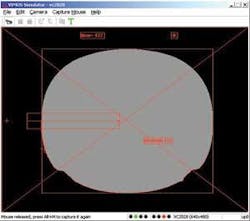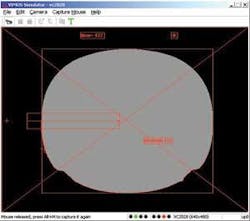Smart camera speeds flask production
Andrew Wilson, Editor, [email protected]
A manufacturer of plastic flasks in Hungary found that the process of orienting and closing the flasks caused a bottleneck. Previously, this bottleneck was overcome by three operators who manually oriented the bottle caps properly before manufacturing. However, to speed the process and to eliminate any operator error, the company decided to automate the process using a machine-vision system.
“After each flask is automatically filled, caps are affixed to the bottles and closed,” says Szabo Jozsef of Pictron (Budapest, Hungary; www.pictron.hu). “Because these caps are not symmetrical, the flasks need to be sorted before they can be labeled so that they always arrive in the proper orientation after traveling along a transport belt. To do this, the position of each flask is identified, and, if incorrectly oriented, each flask is then reoriented by 180° around a vertical axis.”
With the speed of the conveyor, using a robot to lift and turn the flasks around was not viable; therefore, a mechanical U-shaped buffer from XXL Mechanikai Mérnöki Iroda (Budapest, Hungary; www.xxlmechanika.hu) was placed in the production line. If the incorrectly oriented flasks are pushed to the return path of the U-shaped section, they are turned to the correct position, while the properly oriented flasks proceed to the capping station.
To control the operation of the buffer, images of each flask are taken and assessed by a VC2028 intelligent camera from Vision Components (Ettlingen, Germany; www.vision-components.com). To analyze the images as they pass under the inspection station, Pictron uses the VIMOS developing system from atto Systems (Sophia, Bulgaria; www.atto-systems.de). VIMOS is an icon-based visual development environment and tracking system that runs on a PC and requires no programming to create a machine-vision application. All the necessary image-processing modules and control functions are selected through a graphical interface.
To compute the orientation of the flasks is not trivial, because the flasks could be turned from their proper orientation by ±40°. To perform the computation, the top of the flask is digitized, binarized, and outlined, and the center of gravity is computed. Then, the distances of contour points from the center of gravity are calculated and a list of distances generated. This list is compared with a list previously generated from a golden template image and the orientation of the cap computed (see image).
After the program is prepared and tested on a PC, it is loaded into the camera using atto System’s Simulator program. In addition to uploading the program and saving the image, the program can be tested and measurement parameters changed. The Simulator also records the changes on the graphic interface. The VC2028 has direct VGA output so during the final test period a VGA monitor can be used to view the digitized images. Should a flask be incorrectly oriented, four digital I/O lines from the camera are used to control a PLC from Omron (Schaumburg, IL, USA; oeiweb.omron.com), which operates pneumatic cylinders that push the flasks to the U-shaped buffer.
According to Pictron’s Jozsef, the system has successfully been installed, doubling the throughput of the system and replacing the three operators who were previously employed to watch the line and turn incorrectly oriented flasks.

